As Mom gets older, and weaker, I know that there will most likely come a time when I may need a patient lift to move her, and in my case it will be sooner rather than later, due to back injury. So I was wondering about assistance from Medicare with the cost, and I have done a little digging…
Original Medicare Part B will likely cover 80% of a full-body or stand-assist patient lift, if they are prescribed for you by a Medicare-enrolled physician as medically necessary, and bought from a Medicare-enrolled supplier.
Contents Overview & Quicklinks
What are Medicare’s qualifying guidelines for a patient lift ?
What patient lifts does Medicare cover ?
Does Medicare cover Hoyer lifts ?
Does Medicare cover electric Hoyer lifts ?
Medicare face-to-face encounter for a Hoyer lift
Hoyer lift Medicare documentation
How much does it cost to rent a patient lift ?
How much does it cost to buy a patient lift ?
Don’t confuse bathroom lifts with patient lifts
Does Medicare cover lift chairs ?
Does Medicare cover bathroom equipment ?
What equipment does Medicare cover ?
How do you get coverage from Medicare Part B for DME ?
Now you have your signed prescription, what do you do with it ?
Locate a Medicare-enrolled DME Supplier near you
Do Medicare Advantage Plans cover patient lifts ?
List of durable medical equipment typically covered by Medicare
Get free assistance with understanding Medicare
Does Medicaid cover patient lifts ?
How to find the HCBS programs, waivers and 1915 waivers in your state ?
What is the procedure for applying to Medicaid, state waivers and HCBS programs for DME coverage ?
What are patient lifts ?
Patient lifts are devices which are used to transfer a disabled individual who cannot walk, to a chair, a wheelchair, a bedside commode or another location.
You can use a patient to lower a disabled person onto a toilet, or into a bathtub, but they are not to be confused with a bath lift, or a toilet lift, which are separate devices which are attached to the toilet, or placed in the bath, but cannot lift and transport an individual who cannot walk, from one location to another.
Seat lifts are also a different category of lift, and these are for people who are unable to stand up without a lift, but who can walk with, or without, an assistive device.
Patient lifts are either manual or electric.
What are Medicare’s qualifying guidelines for a patient lift ?
You will typically qualify for Original Medicare Part B’s partial coverage of a patient lift for use in the home –
If you cannot get from your bed to a chair, wheelchair or a commode without the use of a lift, and would otherwise be confined to the bed.
You will typically qualify for Original Medicare Part B coverage for a multi-positional patient transfer system in the home –
If you meet the criteria above, and also need to be transferred in a supine position, which simply means lying horizontally and face up.
What patient lifts does Medicare cover ?
If you qualify for a patient lift with Original Medicare, it will be for a manual patient lift.
Original Medicare Part B does not cover electric patient lifts – they are listed as convenience items and won’t be covered.
The Hoyer lift is a very popular manual full body patient lift which is covered by Medicare.
The manual patient lifts are hydraulic, and are operated by manually pumping a hydraulic cylinder prior to performing the lift.
Does Medicare cover Hoyer lifts ?
Original Medicare Part B typically cover 80% of the cost of a manual full-body, or stand-assist Hoyer lift, if prescribed for you by a Medicare-enrolled physician, and bought from a Medicare-enrolled supplier.
Medicare will, as with most large items, usually rent the Hoyer lift, rather than buy it.
Does Medicare cover electric Hoyer lifts ?
Original Medicare Part B does not cover electric patient lifts of any brand, it only covers a manual patient lift.
Medicare lists electric lifts as being convenience items which are to be “denied”.
Medicare face-to-face encounter for a Hoyer lift
You are required to have had a “face-to-face encounter” with the prescribing Medicare-enrolled physician, for your Medicare Part B claim for a patient lift, within six months prior to the sending of the written order for the item.
During this face-to-face encounter, the physician has to examine you and to evaluate your health and your medical condition, to be able to determine the “medical necessity” of the patient lift. The encounter must be documented, and must show that you are being treated for a condition which supports the items being ordered.
This is not the case with all Durable Medical Equipment, but it is necessary for patient lifts.
The “Policy Article “, on patient lifts, states –
REQUIREMENTS FOR SPECIFIC DMEPOS ITEMS PURSUANT TO Final Rule 1713 (84 Fed. Reg Vol 217)
Final Rule 1713 (84 Fed. Reg Vol 217) requires a face-to-face encounter and a Written Order Prior to Delivery (WOPD) for specified HCPCS codes.
The source for the above text is on the Centers for Medicare & Medicaid Services website here, to see the page on Patient Lifts click – here.
Hoyer Lift Medicare documentation
To see the exact Medicare guidelines by which they will grant coverage for a patient lift, you can go here.
Patient lift rentals
Patient lifts are part of Medicare’s “Capped Rental” category.
In this category you can choose to purchase, or to rent your item, from a Medicare-approved supplier.
If you choose to rent –
You will pay your annual deductible (if you haven’t already) at the outset.
Each month, you will pay your 20% co-insurance of the Medicare-approved monthly rental price and maintenance (if you used a Medicare-enrolled equipment supplier who accepts assignment). Medicare Part B will pay the other 80% of the Medicare-approved price.
If your supplier does not accept assignment, you may pay up to 15% more.
After Medicare has made 10 monthly rental payments for your patient lift, you will be asked if you wish to purchase your equipment.
In the 9th month you will be notified of the “purchasing option” you need to reply within 30 days.
When you select to buy the lift, Medicare makes 3 final payments and the lift is yours.
Medicare continues to cover 80% of the maintenance costs for your patient lift, and you have to find a supplier for that.
When you select to continue renting, Medicare continues to pay until it has reached 15 monthly payments, and you can continue to use the lift as long as you wish.
The patient lift will belong to the supplier, and they are also going to be responsible for its maintenance.
How much does it cost to rent a patient lift ?
The patient lifts that Medicare covers cost between roughly $900 – $1600.
How much does it cost to buy a patient lift ?
If you buy a patient lift from a Medicare-enrolled Participating supplier (the supplier accepts assignment, meaning they agree to sell the product at the Medicare-approved price only) the cost of a patient lift is between roughly $900 – $1,600.
If the Medicare-enrolled supplier from whom you buy your patient lift, is not a Participating supplier (does not accept assignment), the supplier can charge up to 15% more for the patient lift.
How much do you pay –
With Medicare Part B coverage, you will have your deductible to pay (unless you have already paid that) and your co-insurance of 20% of the price.
Medicare Part B will pay 80% of the Medicare-approved price.
Don’t confuse bathroom lifts with patient lifts
Don’t confuse bathroom lifts, such as bath lifts and toilet lifts, with patient lifts.
Patient lifts are for disabled individuals who cannot even get out of bed on their own, whereas bath lifts and toilet lifts are for those who have issues with mobility, but who can still walk, even if it is with the aid of some kind of device.
Bath lifts and toilet lifts are not covered by Original Medicare Part B, as they are considered to be convenience devices and not primarily medical in nature.
You can find the coverage determination for all the devices at CMS.gov – Center for Medicare and Medicaid Services – in the National Coverage Determination (NCD) for Durable Medical Equipment Reference List (280.1), which you can read here.
Does Medicare cover lift chairs ?
Lift chairs come under the category “seat lifts” for Original Medicare.
Electric “seat lifts” are not covered, but mechanical/hydraulic seat lifts may be considered if all the criteria are met.
Lift chairs are only partially covered by Original Medicare – they will typically give 80% coverage for the mechanical element of a lift chair for “use in the home”, so long as it has been prescribed as “medically necessary” by a Medicare-enrolled physician.
Original Medicare does not cover seat lift mechanisms which have a spring release mechanism, and jolt you up to a standing position, and which do not have a recliner to return you gently to a seated position.
Medicare qualifying diagnosis for a lift chair ?
The qualifying guidelines for Original Medicare to give coverage for a seat lift mechanism are the following –
“Indications and Limitations of Coverage
Reimbursement may be made for the rental or purchase of a medically necessary seat lift when prescribed by a physician for a patient with severe arthritis of the hip or knee and patients with muscular dystrophy or other neuromuscular diseases when it has been determined the patient can benefit therapeutically from use of the device. In establishing medical necessity for the seat lift, the evidence must show that the item is included in the physician’s course of treatment, that it is likely to effect improvement, or arrest or retard deterioration in the patient’s condition, and the severity of the condition is such that the alternative would be bed or chair confinement.”
Source: National Coverage Determination (NCD) for Seat Lift (280.4) – which you can find here, on the Center for Medicare and Medicaid Services website, CMS.gov.
Simply put, the criteria for qualifying for coverage for a Seat Lift are –
- you must have severe arthritis of the hip or knee or neuromuscular disease
- you must be incapable of standing up from a standard chair with or without arms in the home
- the seat mechanism must be part of the physician’s course of treatment for you to “effect improvement, or to arrest or retard deterioration” in your condition
- once you stand, you are then able to walk
Medicare Certificate of Medical Necessity for a lift chair ?
Once your physician has arrived at a diagnosis for your condition, he or she, will be required to submit what is called a Certificate of Medical Necessity for Seat Lift Mechanisms.
You can see the form here on the Center for Medicare and Medicaid Services website https://www.cms.gov/medicare/cms-forms/cms-forms/downloads/cms849.pdf
How to find a lift chair supplier ?
Your physician will doubtless be able to point you in the right direction for equipment suppliers who are approved by Medicare.
But you can also find out by simply clicking here to go to the Medicare.gov website to use their Medicare-enrolled supplier locator.
Just enter your zip code, and you will get a list of suppliers in your area that you can see on the screenshot of their web page below.

Does Medicare cover bathroom equipment ?
A lot of safety equipment which is designed to help the elderly maintain independence in their homes, is not going to be covered by Original Medicare Part B.
A lot of bathroom safety equipment, for example, is not “medically necessary” according to Medicare, but rather, is either “primarily not medical in nature” and “for convenience”, or “for comfort”.
As a result, Medicare doesn’t really give coverage to that many items of bathroom safety equipment.
The following safety items for the bathroom are not covered by Medicare –
- grab bars
- raised toilet seats
- bath lifts
- floor to ceiling poles
- shower chairs
- bath chairs
- toilet safety frames
For those with serious mobility issues, Original Medicare Part B does give coverage to the following assistive equipment, and it can be used in the bathroom to make it a safer place –
- crutches
- walkers
- bedside commodes
The bedside commodes can be used in at least three situations –
- as a bedside commode
- as a raised toilet seat
- as a safety frame for the toilet
And if the bedside commode is a waterproof model, as a shower chair.
Walkers which are waterproof can also be used in the shower as an aid to standing, as well as an aid for getting into a shower which has a step-up, something which my mom does.
If you have a Medicare Advantage Plan, or Medicare Part C, you possibly already have your bathroom safety equipment covered, if you are suffering from a chronic illness.
In 2020 the first Medicare Advantage Plans were rolled out which were allowed to offer new benefits for individuals with chronic illnesses, and bathroom safety equipment was offered as a benefit by some for certain illnesses.
What equipment does Medicare cover ?
In general, Original Medicare Part B will cover 80% of the cost of durable medical equipment, or DME, for use in the home, so long as it is medically necessary, prescribed by a physician who is Medicare-enrolled, and it is bought from a Medicare approved supplier.
I have a long list of qualifying durable medical equipment covered by Original Medicare Part B which you can jump down to see here.
For equipment to be considered as Durable Medical Equipment by Medicare, it needs to qualify under the following criteria :-
- Durable (can withstand repeated use)
- Used for a medical reason
- Not usually useful to someone who isn’t sick or injured
- Used in your home
- Generally has an expected lifetime of at least 3 years
Source: Medicare.gov website – here.
The classic types of medical equipment to which Medicare gives coverage are things like wheelchairs, crutches and walkers, which are seen as medically necessary.
Original Medicare Part B coverage typically extends to 80 % of the Medicare-approved cost of any durable medical equipment, and you will have to pay your co-insurance payment of 20%, and, if it applies, your deductible.
What Original Medicare Part B doesn’t give coverage to, are what it calls “comfort or convenience items“, things such as shower chairs, air purifiers or a wigs.
A lot of electrical versions of equipment are labelled as “convenience items”, and if a manual version exists, Medicare feels that be used to do the job.
What’s important here is that Medicare has to save on costs where it can, and electrical devices cost a lot more than their manual versions.
How to get coverage from Medicare Part B for DME ?
Coverage from Original Medicare Part B for durable medical equipment for “use in the home” is given only if –
- you are enrolled in Medicare Part B
- you have your Medicare-enrolled doctor sign a prescription certifying that the equipment is a “medically necessary”
- you purchase, or rent, the DME through a Medicare-enrolled supplier
How does Original Medicare define “living at home” ?
Original Medicare defines “living at home” as –
- living in your own home
- living in the family home
- living in the community, such as assisted living
Now you have the signed prescription, what do you do with it ?
Once you have your prescription in hand –
- locating a Medicare-enrolled DME supplier is going to be first – you can ask your physician, or just go to the supplier locator in the next section of this article
- don’t use anyone but a Medicare-enrolled “participating” supplier who accepts “assignment” – it will keep your costs in check
- choose the equipment, with the supplier, which corresponds to your prescription – the prescription will have special codes which indicate which models, of which equipment, you are allowed
- check that all your Medicare paperwork is done correctly with the supplier, so that you comply with the Original Medicare coverage guidelines
If you have followed the process as outlined, Original Medicare part B typically covers 80% of the Medicare-approved price for your DME.
If you are purchasing, or renting, your DME from a Medicare-enrolled “participating” supplier who accepts “assignment”, then you will have to cover your Medicare 20% coinsurance payment of the Medicare-approved price of the DME, and your policy deductible if it applies.
Do be sure to confirm that the supplier is a Medicare-enrolled “participating” supplier who accepts “assignment” !
Locate a Medicare-enrolled DME Supplier near you
Find a Medicare-approved supplier who is local to you – here.
Do Medicare Advantage Plans cover patient lifts ?
Medicare Advantage plans are provided by companies contracted by Medicare to give all the Medicare services, and to cover everything that Original Medicare Parts A and B cover, and that includes patient lifts if you qualify under the Medicare guidelines.
As of the last quarter in 2020, Advantage plans have been allowed to extend the number of extra benefits they offer, with particular emphasis on beneficiaries with chronic conditions.
With regard to how to get coverage and where to get equipment, that depends on who your provider is, and you will need to ask them about suppliers and the procedure.
List of durable medical equipment covered by Medicare
To qualify, you will need to have Original Medicare Parts A and B.
Air-Fluidized Bed
Alternating Pressure Pads and Mattresses
Audible/visible Signal Pacemaker Monitor
Pressure reducing beds, mattresses, and mattress overlays used to prevent bed sores
Bead Bed
Bed Side Rails
Bed Trapeze – covered if your loved one is confined to their bed and needs one to change position
Blood sugar monitors
Blood sugar (glucose) test strips
Canes (however, white canes for the blind aren’t covered)
Commode chairs
Continuous passive motion (CPM) machines
Continuous Positive Pressure Airway Devices, Accessories and Therapy
Crutches
Cushion Lift Power Seat
Defibrillators
Diabetic Strips
Digital Electronic Pacemaker
Electric Hospital beds
Gel Flotation Pads and Mattresses
Glucose Control Solutions
Heat Lamps
Hospital beds
Hydraulic Lift
Infusion pumps and supplies (when necessary to administer certain drugs)
IPPB Machines
Iron Lung
Lymphedema Pumps
Manual wheelchairs and power mobility devices (power wheelchairs or scooters needed for use inside the home)
Mattress
Medical Oxygen
Mobile Geriatric Chair
Motorized Wheelchairs
Muscle Stimulators
Nebulizers and some nebulizer medications (if reasonable and necessary)
Oxygen equipment and accessories
Patient lifts (a medical device used to lift you from a bed or wheelchair)
Oxygen Tents
Patient Lifts
Percussors
Postural Drainage Boards
Quad-Canes
Respirators
Rolling Chairs
Safety Roller
Seat Lift
Self-Contained Pacemaker Monitor
Sleep apnea and Continuous Positive Airway Pressure (CPAP) devices and accessories
Sitz Bath
Steam Packs
Suction pumps
Traction equipment
Ultraviolet Cabinet
Urinals (autoclavable hospital type)
Vaporizers
Ventilators
Walkers
Whirlpool Bath Equipment – if your loved one is home bound and the pool is medically needed. If your loved one isn’t home bound, Medicare will cover the cost of treatments in a hospital.
Prosthetic and Orthotic Items
Orthopedic shoes only when they’re a necessary part of a leg brace
Arm, leg, back, and neck braces (orthotics), as long as you go to a supplier that’s enrolled in Medicare
Artificial limbs and eyes
Breast prostheses (including a surgical bra) after a mastectomy
Ostomy bags and certain related supplies
Urological supplies
Therapeutic shoes or inserts for people with diabetes who have severe diabetic foot disease.
Corrective Lenses
Prosthetic Lenses
Cataract glasses (for Aphakia or absence of the lens of the eye)
Conventional glasses or contact lenses after surgery with insertion of an intraocular lens
Intraocular lenses
Important: Only standard frames are covered. Medicare will only pay for contact lenses or eyeglasses provided by a supplier enrolled in Medicare, no matter who submits the claim (you or your supplier).
Get free assistance with understanding Medicare
SHIP – State Health Insurance Assistance Programs
Your state offers free counseling services over the phone for Medicare, Medicaid and Medigap at your State Health Insurance Assistance Program.
To locate your SHIP contact info, you can check my article here – “Free Help Understanding Medicare And Medicaid ? Here’s Where You Get It”.
Does Medicaid cover patient lifts ?
Medicaid is funded both federally, and by the individual states, and because of this, it may often agree to waive some requirements for eligibility for its different programs.
The programs on which Medicaid agrees to waive requirements are called “waivers”.
Waivers are designed to offer assistance to different parts of the population who might otherwise be missing out on healthcare – there are many waivers across the US which are specifically for helping the elderly to remain in their homes, and which offer financial assistance with DME.
Health Care in the home – Medicaid and state programs
Programs designed specifically for low income families, the disabled and the elderly, for care “in the home”, are called “Home and Community Based Services” (HCBS), “Waivers” or “1915 Waivers”.
The mission of the programs, is to help the participants to remain living in their homes, and to maintain their independence in the community.
To help the participants, the programs, and waivers, will all cover “home medical equipment” – DME – and will often cover as much as 100% of the cost.
If you want to check your eligibility for any programs, contact your State Medicaid Agency here.
To learn more about HCBS programs, or waivers, you can go here on Medicare.gov – https://www.medicaid.gov/medicaid/hcbs/authorities/index.html
These programs use the term “home” to mean the following –
- their own home
- their family home
- a group home
- an assisted living facility
- a custodial care facility
Some programs and waivers offer greater breadth in their interpretation of DME covered for care in the home
Two types of state programs which allow for a wider interpretation of what durable medical equipment coverage are –
HCBS programs and waivers which employ a system of beneficiary budget management called either “Consumer Direction” or “Self Direction”.
To find out more about Medicaid Self Direction, click here.
The Medicaid program “Money Follows The Person”
Medicaid set up this program to help elderly adults transition from living in nursing homes, back to their own homes.
And it now supports individual states by funding them, to either build a new “Money Follows The Person” program in their state, or to modify an existing program in their state.
Programs will pay for the items and modifications, which are necessary for the participants to be able to live safely, and independently, in their own homes again.
Remodeling parts of the home to make things safer and easier, improved lighting, building ramps etc., or just providing the basic DME, are all part of and paid for by the program.
How to find the HCBS programs, waivers and 1915 waivers in your state
If you want to know more about the Medicaid HCBS waivers and programs for the elderly in your state, you can take a look at my guide, which details them by state. You can find the guide here – “Medicaid Home and Community Based Services Waivers and Programs For Seniors Listed By State”.
What is the procedure for applying to Medicaid, state waivers and HCBS programs for DME coverage ?
Step 1
– the doctor, or therapist, has to provide a medical justification letter, stating it is medically necessary
Step 2
– find a Medicaid-approved DME supplier, and give them the medical justification letter
Step 3
– the Medicaid-approved supplier fills out a Prior Approval Application form for Medicaid
Step 4
– the Prior Approval Application is sent to the Medicaid State Office
Step 5
– if you are unsuccessful you will be contacted and given the reasons as to why, as well as advice on how to make an appeal
Step 6
– if approved, you will receive the DME
If your income is a bit too high to qualify for Medicaid
Spend Down Programs
Medicaid’s Spend Down programs work to reduce a program participant’s income level, asset level or both, so that they may become eligible for Medicaid coverage.
There are two methods –
- Income Spend Down
- Asset Spend Down
The program allows the participants to deduct some medical expenses, loan payments and different debt repayments.
I’ve written an article about how it works here – “What is Spend Down ?”.
To locate your Medicaid State Agency
If you want to discuss things, or to email someone, you can contact your state Medicaid Agency here.
Step 1 –
Click the link to Medicaid.gov and look for the section that I have outlined in red.
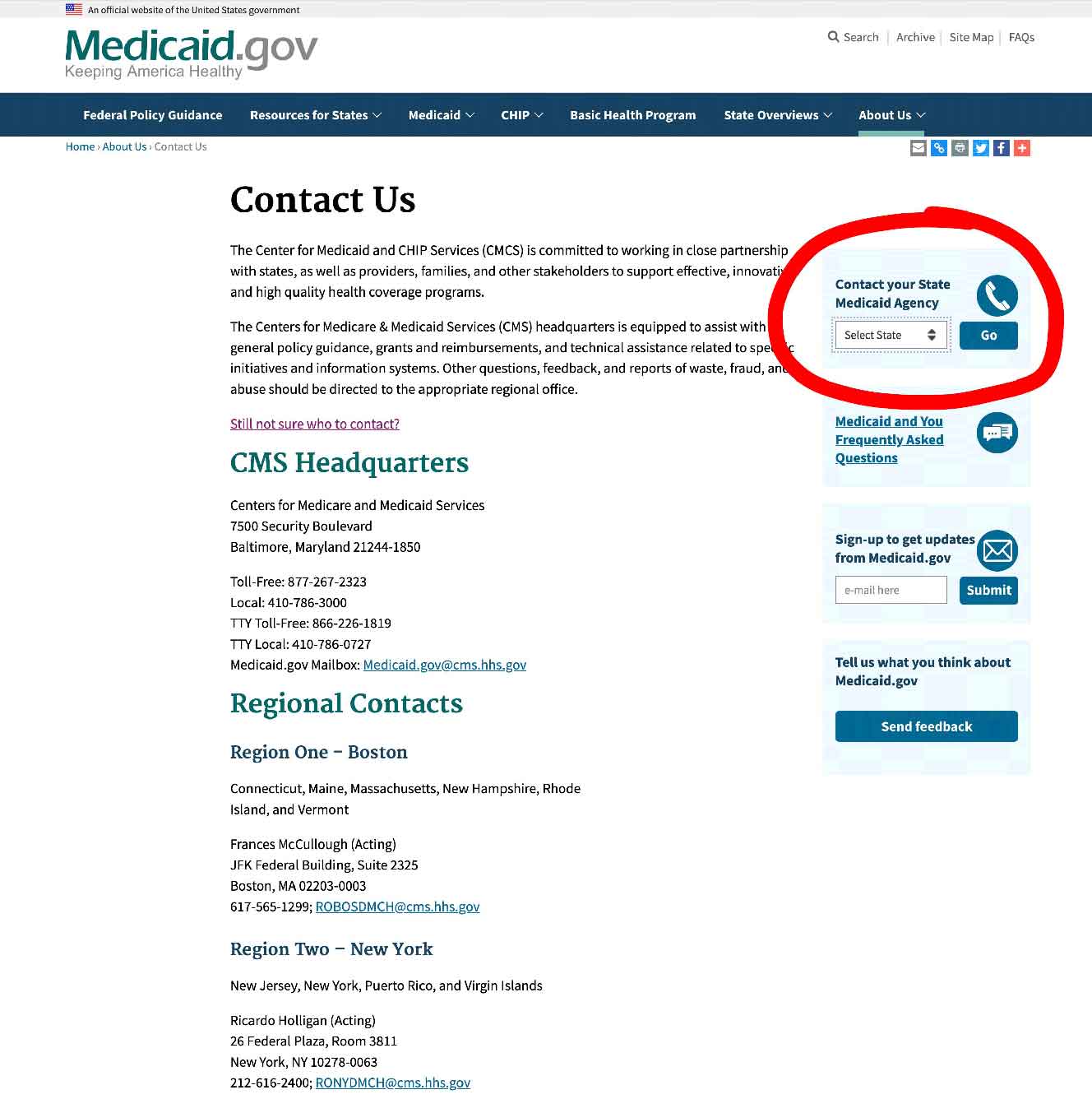
Step 2 –
Select your state and click on the button marked “GO” – it will take you to your State Medicaid Agency with all their contact info.
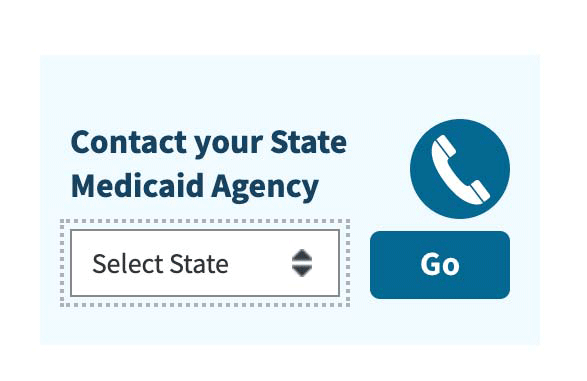
State Funding Assistance for the elderly
State Assistive Technology Programs
Assistive Technology Programs are designed to improve access to assistive devices in the home.
These projects are in all states and are primarily for the elderly and the disabled.
State Assistive Technology Programs generally offer a number of services, of which these are of the most interest to us here –
- an online equipment exchange, on which you can post assistive devices and medical equipment for sale, donating or exchanging – you can simply register on your state exchange website and participate
- a central website on which you can make contact to find out about eligibility and how to gain access to free or low cost equipment
- reuse, recycling and refurbishment programs run by the state program, or by partners – community groups – providing free, or extremely low cost equipment for the disabled, the elderly and other disadvantaged individuals
- loan closets can also be part of the programs, and these can be short or long term loans
Assistive Technology Programs will also help to find equipment for individuals who make contact and enroll with the program.
You can find out much more about all of this on your state assistive technology program website.
To see what AT Projects are in your state, click here.
Step 1/
Pick your state on the map or the drop-down menu, and click on “Go to state”
– I chose Florida for this example
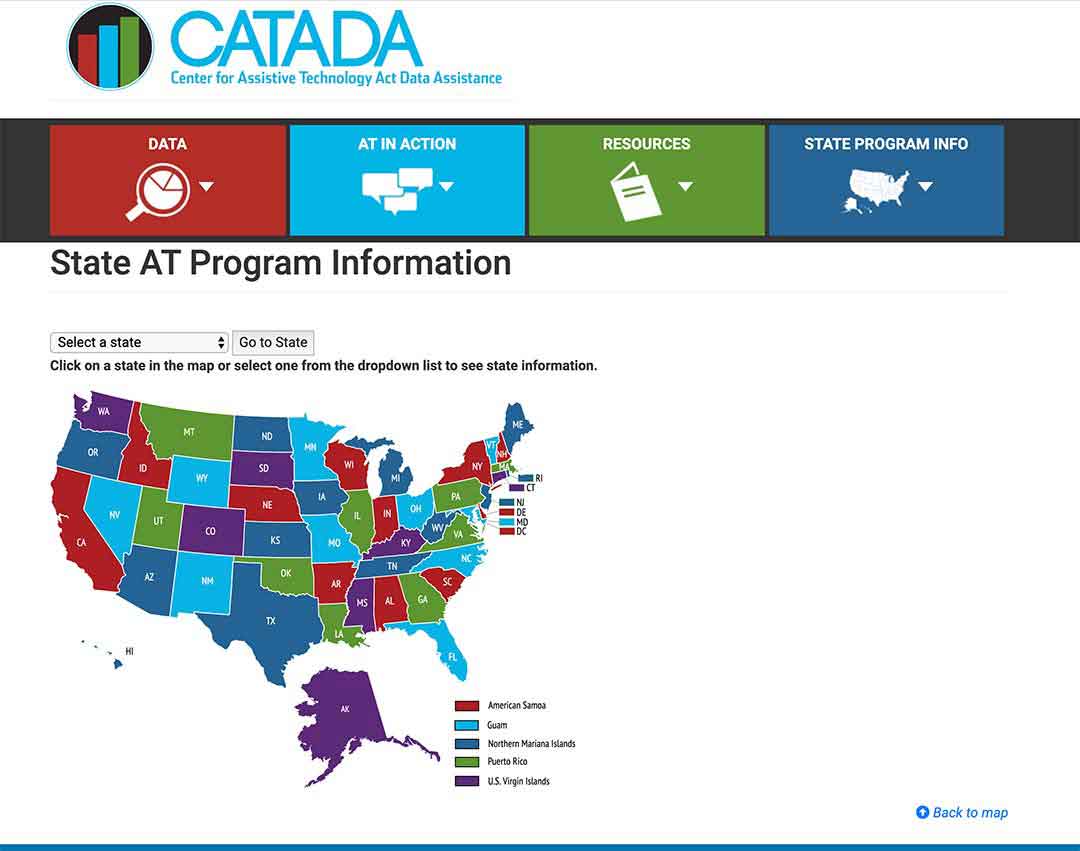
Step 2/
Click on the link “Program Title” – for my example, I outlined it in red.
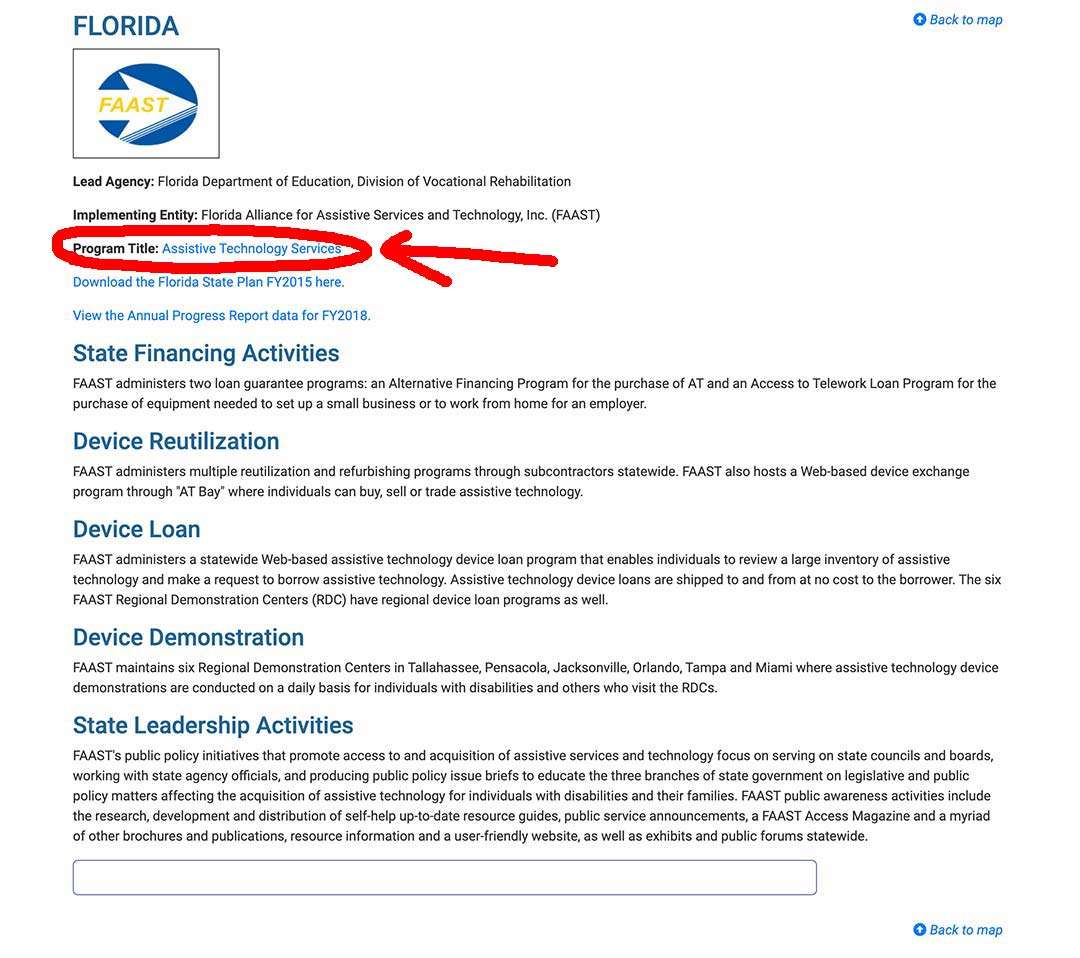
Step 3/
The AT Program state website will come up, and you can sign up, or use their contact info.
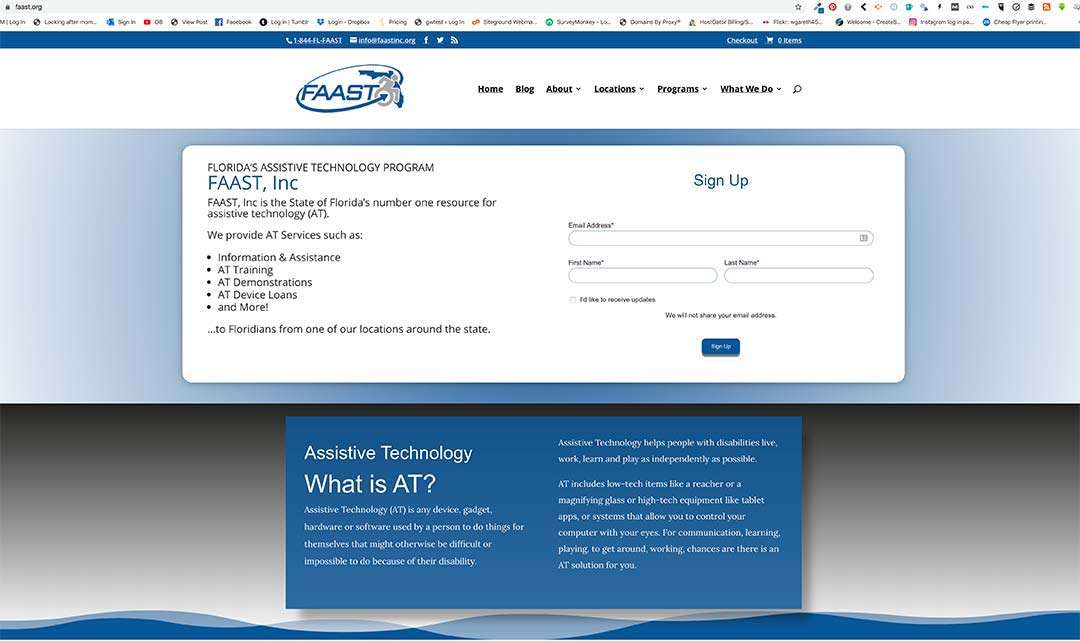
State Financial Assistance Programs
Non-Medicaid state programs, designed to assist the elderly and the disabled to maintain, a more or less, independent lifestyle in their own homes, exist in a number of states – usually known as State Financial Assistance Programs.
A wide range of assistive devices, safety equipment and home modifications can be covered by State Financial Assistance Programs if they are needed to help the elderly beneficiary maintain their independence.
The costs may be paid for with grants or loans, or both.
Your local Area Agency on Aging should be available to tell you if your state has a Financial Assistance Program – you can locate an Area Agency on Aging near you here.
I’m Gareth, the author and owner of Looking After Mom and Dad.com
I have been a caregiver for over 10 yrs and share all my tips here.

